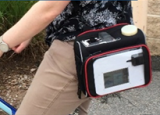Educational Resources Related to Air Sensor Technology
Air sensor technologies are increasingly being used by a variety of audiences and offer opportunities for educational enrichment. EPA developed several presentations that provide background information on air quality, air pollution sources, and air sensors. Additionally, EPA and collaborators developed educational activities and curriculum which are available to the public. These resources may be used in group settings such as classrooms or community workshops, in other educational settings, or by individuals exploring on their own. These materials may also be adaptable for a variety of age groups from elementary school students to adults.
Disclaimer: Mention of trade names or commercial products does not constitute U.S. EPA endorsement or recommendation for use.
On this page:
- Introductory Presentation on Air Quality and Air Sensors
- Air Sensor Loan Programs - Air Quality Lesson Plans
- Using Vegetative Barriers to Improve Air Quality – Activities and Lessons for K-5 Educators
- Build your Own Particle Sensor Kit
- AirMapper and RETIGO Lesson Plans
- Science to Achieve Results (STAR) Grant Funded Resources
Introductory Presentations on Air Quality and Air Sensors
To help facilitate the use of air sensors, EPA developed several presentations that overview general and more technical information on air quality, air pollution, and air sensors. The presentations include:
- Air Quality 101: A Background on Air Pollution Presentation Slides – covers several topics including the history of air pollution and regulation in the US, common air pollutants and their sources, the health and environmental effects of air pollution, how air pollutants are measured in the US, and where air quality data can be found.
- Introduction to Air Sensors Presentation Slides – provides background information on air sensors, difference between sensors and regulatory monitors, uses for sensors, planning and conducting studies using air sensors, quality assurance and quality control, using air sensor evaluations, data analysis, and additional resources. Also available on YouTube:
- Advanced Topics in Using Sensors to Measure Air Quality Presentation Slides – covers the difference between air sensors and regulatory monitors, interpreting air sensor evaluations, and sensor collocation, siting, quality control, and data analysis.
Air Sensor Loan Programs – Air Quality Lesson Plans
Between 2019 and 2021, EPA launched pilot air sensor loan programs with several local partners associated with public libraries, public museums, and tribal communities. To support those programs and to encourage the use of air sensor technology for air quality education, a series of educational resources were developed.
These resources include hands-on lesson plans for classroom, group, or individual instruction. The lesson plans are written for the AirBeam2 or PurpleAir sensors but are adaptable for use with any handheld particulate matter (PM) sensor or stationary PM sensor with a crowdsourced map, respectively. The available lesson plans include:
- What is in the Outdoor Air? Exploring Particulate Matter (PM) Sources and Air Quality Outdoors
- Hidden Particulate Matter Indoors! Explore Your Environment
- My Pollution Bubble! Exploring My Personal Particulate Matter (PM) Exposure
- The Power of Plants! How Vegetation Can Help Protect Us from Air Pollution
- Is That Smoke Affecting Me? Using Crowdsourced Public Data to Explore Air Quality During Smoke Events
Each lesson plan includes:
- Instructor guide that includes discussion points and answers to the questions posed to the participants
- Participant guide which includes a worksheet for observations and discussion question responses
- Slides introducing the topic and activity
- Summary of how the lesson aligns with Next Generation Science Standards (NGSS)
- Resource guide to connect users to additional information and activities
- Frequently asked questions document to answer common inquires
In addition to the introductory presentation mentioned in the section above, the following resources may also provide support for these lesson plans:
- AirBeam2 Quick Start Guide and Presentation Slides
- AirBeam2 Instructional Video (approximately 13 minutes long)
- PurpleAir Quick Start Guide and Presentation Slides (coming soon)
For questions or more information, please contact Andrea Clements ([email protected]) and Rachelle Duvall ([email protected]).
Using Vegetative Barriers to Improve Air Quality – Activities and Lessons for K-5 Educators

Vegetative barriers, which include trees and bushes, can help reduce pollution near busy highways and roads. EPA has been researching how vegetative barriers can improve air quality. Researchers developed custom-built air sensors that can be used to measure air quality to see the effects of vegetative barriers over time. As part of this research, K-5 lesson plans and activities have been developed that focus on air quality, air sensors, air pollution, and the impact of air pollution on human health. Although written with the custom-built air sensor in mind, these lessons are adaptable to other types of air sensors.
For questions, contact Rebecca Dodder ([email protected]).
Build your Own Particle Sensor Kit

Particle pollution, known as particulate matter (PM), is one of the major air pollutants regulated by EPA to protect public health and the environment. A PM air sensor kit was developed by EPA researchers as an educational tool to teach the public about air quality and air science. This activity can be completed in under an hour and gives hands-on experience with electronics and coding, but it is not intended to be used as a long-term air monitoring device. This resource provides instructions on buying the parts for the kit, step-by-step instructions for assembly, and a lesson plan.
AirMapper and RETIGO Lesson Plans

The AirMapper is a custom-built portable air monitoring device that was developed by EPA. The device measures fine particulate matter (PM2.5), carbon dioxide (CO2), and other parameters, including temperature, humidity, and noise. Data collected on the AirMapper can be downloaded and viewed using the RETIGO web-platform. Six lesson plans and five classroom activities were developed based on the AirMapper and RETIGO. These resources are designed for 3rd to 8th grades.
Additionally, a manual for the AirMapper has been developed for anyone who wants to build this device. The manual includes instructions on buying the parts for the device, assembly, operation, and troubleshooting.
To obtain the lesson plans, contact Rachelle Duvall ([email protected])
Science to Achieve Results (STAR) Grant Funded Resources
University of Washington - Air Pollution Monitoring for Communities
This curriculum was used by university researchers in an after-school program with high school students mentored by undergraduate students. The program focused on preparing students to conduct their own research on particulate matter using low-cost sensors.
